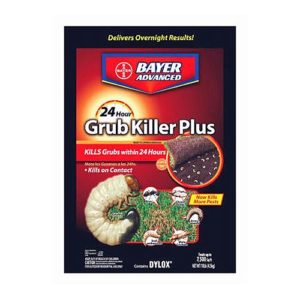Root maggots can be extremely destructive garden pests. As they feed they can destroy the root systems of plants causing slow and irregular growth and even death. They are particularly troublesome for early season plantings.
Unseen, underground, they feed on the root systems of many different vegetable crops including cabbage, radishes, turnips, carrots, and onions. Plants suffering from root maggot attacks may appear yellowish, stunted, and will sometimes wilt during the day when sunlight is at its peak. Tunneling that occurs as the maggots feed also leaves plants open to rot diseases such as black rot.
How to Identify Root Maggots

Kills over 230 different pests, including root maggots. Check price on Amazon.
Adults are dark grey flies that look like a common housefly, only smaller. They are about ⅕ of an inch in length. They will lay their eggs in the soil at the base of their chosen host plants. The maggots which hatch from the eggs are yellowish-white, legless larvae. They have a tapered or even pointed head and their tail end is blunt.
Root Maggot Life Cycle
Adults first emerge in the early spring from pupal cocoons in the soil where they’ve spent the winter. They will begin to mate quickly. Females can deposit anywhere from 50 to 200 eggs at a time. They will lay their eggs in plant stems at the soil line, or in cracks in the soil close to the plant stems.
Within a few days, the eggs will hatch and the newly born maggots will burrow down into the soil where they will feed on roots, root hairs, and germinating seeds. They will continue to feed for one to three weeks, depending on their environment, before going into the pupal stage to transform into adults. Several generations will be produced each year.
How to Control Root Maggots

Bayer Grub Killer – Kill Grubs in 24 hours. Check price on Amazon
Floating row covers – The female flies are especially attracted to the moisture in newly planted seed rows when it comes time to lay their eggs. Cover new seedbeds, making sure that coverage extends at least 6 inches on all sides of the seed rows. This will prevent the mature females from getting in to lay their eggs in the first place.
Paper collars – When transplanting plants, a heavy paper collar (or other similar material) can be used around the base of the plants to prevent egg laying around the stem.
Beneficial nematodes – Nematodes are microscopic parasites that live naturally in soil. They can be purchased online or in gardening centers. They are safe for plants, people, and pets, but will actively seek out and destroy root maggots as well as many other garden pests. These tiny creatures will also continue to hunt and help your garden for up to 18 months. You can pick up the beneficial nematodes at your local store or purchase through our affiliate link.
Pyrethrin spray – Pyrethrin is a natural insecticide derived from the chrysanthemum flower. It can be effective against root maggots and the adult flies, but you will need to soak the soil well to achieve a good effect on the maggots underground. Bayer Advanced Grub spray is a recommended option for dealing with root maggots, and any pests affecting the roots or soil of your plants.
Rototiller – After harvest, promptly use a rototiller to destroy and bury leftover crop debris. This will help to remove suitable food for any existing root maggots as well as destroy any overwintering sites and cocoons that may exist in the soil.
Root maggots can multiply very quickly if left unchecked. Unfortunately, they can also be hard to identify since they are underground. If you notice yellowing or stunted growth on your plants but can’t seem to find evidence of other pests, it might be well worth your time to get down to the roots of one or two specimens and check for root maggots. The sooner you react to any problem you find, the better the results you’ll get for your efforts.

No Comments